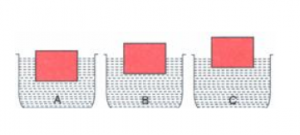Upthrust in Fluids, Archimedes’ Principle and Floatation Exe-5C Floatation Short Answer Type for Class-9 ICSE Concise Physics. There is the solutions of short Answer type Questions of your latest textbook which is applicable in 2023-24 academic session. Visit official Website CISCE for detail information about ICSE Board Class-9.
Upthrust in Fluids, Archimedes’ Principle and Floatation Exe-5C Short Answer
(ICSE Class – 9 Physics Concise Selina Publishers)
| Board | ICSE |
| Class | 9 |
| Subject | Physics |
| Writer / Publication | Concise selina Publishers |
| Chapter-5 | Upthrust in Fluids, Archimedes’ Principle and Floatation |
| Exe – 5C | Floatation |
| Topics | Solution of Exe-5(C) Short Answer Type |
| Academic Session | 2023-2024 |
Exe-5C Floatation Short Answer Type
Ch-5 Upthrust in Fluids, Archimedes’ Principle and Floatation Physics Class-9 ICSE Concise
Page 137
Question 1. A solid iron ball of mass 500 g is dropped in mercury contained in a beaker. (a) Will the ball float or sink? (b) What will be the apparent weight of the ball? Give reasons
Answer:
(a) The ball will float because the density of ball (i.e. iron) is less than the density of mercury.
(b) While floating, the apparent weight = 0.
Question 2. Explain why an iron nail floats on mercury, but it sinks in water.
Hint: Density of iron is less than that of mercury, but more than that of water.
Answer:
Density of iron is less than the density of mercury; hence, an iron nail floats in mercury and density of iron is more than the density of water; hence, an iron nail sinks in water.
Question 3. A homogeneous block floats on water (a) partly immersed (b) completely immersed. In each case state the position of center of buoyancy B with respect to the center of gravity G of the block.
Answer:
When the body is partially immersed, its center of buoyancy will be below the center of gravity of the block.
When the body is completely immersed, its center of buoyancy will coincide the center of gravity.
(Upthrust in Fluids Exe-5C Short ICSE)
Question 4. Fig. 5.15 shows the same block of wood floating in three different liquids A, B and C of densities, ρ1, ρ2, ρ3 and respectively. Which of the liquid has the highest density? Give a reason for your answer.

Answer:
The upthrust on the body by each liquid is the same and equal to the weight of the body.
However, upthrust = Volume submerged × ρL × g,
For the liquid C, since the volume submerged is least so the density ρ3 must be maximum.
Question 5. What is the centre of buoyancy? State its position for a floating body with respect to the centre of gravity of the body.
Answer:
Centre of buoyancy: It is the point through which the resultant of the buoyancy forces on a submerged body act; it coincides with the centre of gravity of the displaced liquid, if the body is completely immersed.
For a floating body with its part submerged in the liquid, the centre of buoyancy is at the centre of gravity of the submerged part of the body and it lies vertically below the centre of gravity of the entire body.
Question 6. A balloon filled with helium gas floats in a big closed jar which is connected to an evacuating pump. What will be your observation, if air from the jar is pumped out? Explain your answer.
Answer:
Observation : The balloon will sink.
Explanation : As air is pumped out from jar, the density of air in jar decreases, so the upthrust on balloon decreases. As weight of balloon exceeds the upthrust on it, it sinks.
Question 7. A block of wood is so loaded that it just floats in water at room temperature. What change will occur in the state of floatation, if
(a) Some salt is added to water, (b) Water is heated?
Give reasons.
Answer:
(a) It will float with some part outside water.
Reason : On adding some salt to water, the density of water increases, so upthrust on a block of wood increases, and hence, the block rises up till the weight of salty water displaced by the submerged part of block becomes equal to the weight of the block.
(b) The block will sink.
Reason: On heating, the density of water decreases, so upthrust on the block decreases and the weight of block exceeds upthrust due to which it sinks.
Question 8. Why is the floating ice less submerged in brine than in water?
Answer:
Density of brine is more than the density of water. Hence, the upthrust exerted by brine is more than the upthrust exerted by water on ice. Therefore, floating ice is less submerged in brine.
Question 9. A man first swims in sea water and then in river water.
(i) Compare the weights of sea water and river water displaced by him.
(ii) Where does he find it easier to swim and why?
Answer:
(i) 1:1; The weight of the water displaced by the man in sea and river will be same and will be equal to his own weight.
(ii) He finds it easier to swim in the sea because the density of sea water is more than the density of river water. So his weight is balanced in sea water with a part of his body submerged in the water.
(Upthrust in Fluids Exe-5C Short ICSE)
Question 10. An iron nail sinks in the water while an iron ship floats on water. Explain the reason.
Answer:
An iron nail sinks in water because density of iron is more than the density of water, so the weight of the nail is more than the upthrust of water on it.
On the other hand, ships are also made of iron, but they do not sink. This is because the ship is hollow and the empty space in it contains air, which makes its average density less than that of water. Therefore, even with a small portion of ship submerged in water, the weight of water displaced by the submerged part of ship becomes equal to the total weight of ship and it floats.
Question 11. A loaded cargo ship sails from sea water to river water. State and explain your observations.
Answer:
A ship submerges more as it sails from sea water to river water.
Density of river water is less than the density of sea water. Hence, according to the law of floatation, to balance the weight of the ship, a greater volume of water is required to be displaced in river water of lower density.
— : End of Upthrust in Fluids, Archimedes’ Principle and Floatation Exe-5C Short Answer Type Solutions :–
Return to Concise Selina Physics ICSE Class-9 Solutions
Thanks
Please share with your friends


